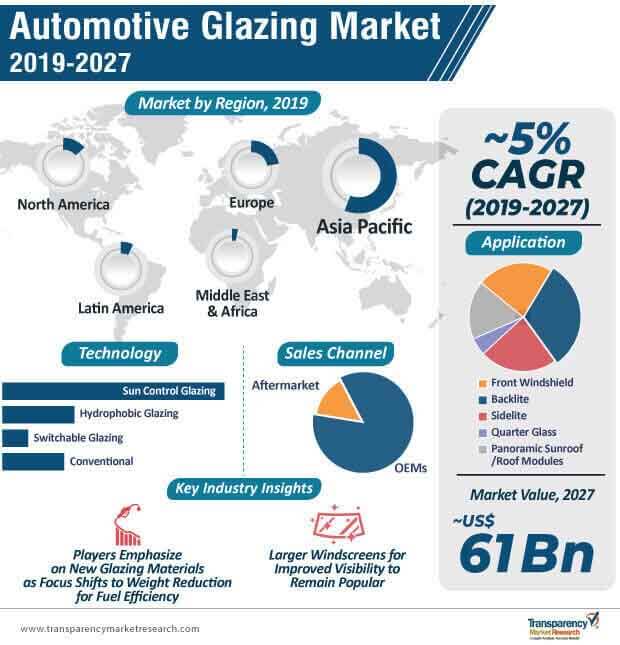
The larger issues of air pollution and carbon emission have had an indisputable impact on the automotive industry, as stakeholders continually work toward the development of better, lighter, and safer components for cars. The influence of this has led to manufacturers in the global automotive glazing market also taking steps to improve existing products and develop new ones that are aimed at reducing the weight of cars, thereby making them more fuel-efficient.
This is particularly significant, as countries are looking to align with the Corporate Average Fuel Efficiency/Economy (CAFÉ) regulations, which mandates manufacturers to produce fuel-efficient vehicles. While some of these newer materials and processes used for automotive glazing are expensive in comparison to traditional materials, they are still being used to reduce weight and improve the efficiency of vehicles. For instance, polycarbonate is lighter and safer in comparison to older types of glass that were used, and its application as windshields and backlites is quickly gaining traction.
Sustainability, a megatrend in manufacturing, has also impacted the evolution of the automotive glazing market, with players increasingly focusing on sustainable alternatives to improve the efficiency of autonomous vehicles, opening up new design options for car makers.
In 2018, the global automotive glazing market registered sales of ~36 Thousand Sqm, which is likely to increase at a volume CAGR of ~3% during the forecast period (2019-2027).

Request a sample to get extensive insights into the Automotive Glazing Market
Hydrophobic Automotive Glazing Gradually Gaining Traction
Since the advent of hydrophobic glazing for glass, it has only seen a stable rise in popularity among consumers and manufacturers alike, for its improved visibility and driving comfort factors. Hydrophobic glass accounted for one-sixth of the total market share by value in 2018, and is set to expand at a moderate pace over the forecast period. Its popularity can be attributed to the increase in the sales of luxury vehicles, in which its adoption remains high.
However, steadily holding the largest share in the automotive glazing market is the sun control glazing technology, which, in 2018, held around two-third of the total market share by value. The benefits that it offers include reduction of UV radiation, contributing to its continuing adoption by manufacturers and increased demand from consumers.
To understand how our report can bring difference to your business strategy, Ask for a brochure
With cars containing a significantly larger percentage of glass as compared to the vehicles from a few decades ago, the potential of these surfaces is ripe for the taking. Manufacturers in the global automotive glazing market are focusing on R&D to improve driving comfort, opening up new prospects to increase the efficiency of vehicles. This includes the development of smart glass technologies. For instance, in June 2019, Continental Corporation, a major player in the global automotive manufacturing landscape, announced enhancements and improvements to its Intelligent Glass Control solution, offering greater comfort, safety, and energy efficiency, overall. Developments of this nature are bound to have a positive impact on the automotive glazing market.
Automotive Glazing: Tempered vs. Polycarbonate Glass
Tempered glass has consistently been the glazing type of choice for manufacturers in the global automotive glazing market, causing it to have a monopoly in the market share in 2018, over other glazing types. While it is likely to remain the most popular among stakeholders, the segment is set to increase at a slow ~3% CAGR by volume during the forecast period. Its attributes of strength and toughness make a significant contribution to its popularity. However, the fastest growing glazing type in the market, by way of popularity, volume, and value, is polycarbonate glazing, which is set to grow at a rapid pace of ~10% over the same period. This popularity can be attributed to the lightness, flexibility, and high thermal resistance of polycarbonates, making them highly suitable for vehicles.
A side-by-side comparison of conventional tempered glass versus polycarbonate demonstrates the superiority of polycarbonate on various fronts, including weight and strength, superior thermal insulation, from the consumer’s POV, and flexibility and ease of installation for manufacturers in the automotive industry.
Read TMR Research Methodology at: https://www.transparencymarketresearch.com/methodology.html
Read Our Latest Press Release:
- https://www.prnewswire.com/news-releases/affordability-and-beneficial-properties-to-serve-as-vital-growth-factors-for-construction-tape-market-during-forecast-period-of-2020-2030-tmr-301221294.html
- https://www.prnewswire.com/news-releases/global-higher-education-solutions-market-to-thrive-on-growing-popularity-of-cloud-computing-and-high-consumption-of-digital-content-tmr-301219732.html





